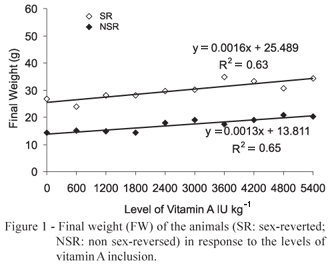Dietary vitamin supplementation decrease stress caused by high stocking density, and boosts immunological system of farmed fish. A studied was carried out to determine vitamin A requirements of Nile tilapia (Oreochromis niloticus) in an all male group (13.8 ± 1.2 g) and a mixed sex population (9.8 ± 2.3 g). Fish stocked in 100-L plastic aquaria (26.0 ± 1.0ºC) were fed to near satiety, twice a day, seven days a week, during 75 days with vitamin A-free, semi-purified diets supplemented with 0; 600; 1,200; 1,800; 2,400; 3,000; 3,600; 4,200; 4,800 and 5,400 International Units (IU) of retinyl palmitate (30% vitamin A) per kg of diet in a completely randomized experimental design, factorial arrangement 2c10 (n = 4). Deficiency signs of vitamin A were observed in fish fed 0 to 1.200 IU vitamin A kg-1 diet; moderate signs were observed in fish fed diets with 1.800 to 3.600 IU vitamin A kg-1 diet; no interactions group*level (p < 0.05) were detected. Dietary levels of vitamin A up to 5.400 IU kg-1 influenced final weight and weight gain of fish (p < 0.05), but did not influence feed consumption (p > 0.05). A group effect was observed regarding all performance variables (p < 0.0001). Quantification of hepatic retinol (HPLC) detected vitamin A only in fish fed 5.400 IU retinol kg-1 of diet, therefore characterizing that dietary retinol was used and stored. The quantity of 5.400 IU of retinol kg-1 of diet is recommended for adequate nutrition of Nile tilapia.
Oreochromis niloticus; retinol; nutrition






